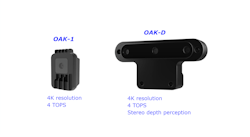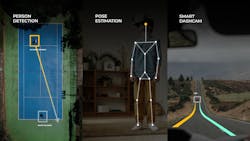Check out more Technology Talks videos.
Luxonis sells intelligent cameras that can implement machine-learning (ML) models directly instead of handing off raw video streams to a host (Fig. 1). Adding artificial intelligence (AI) to a camera offloads the host and reduces communication overhead. It also can simplify host software by providing processed data only when it's needed.
I talked with Luxonis' Bradley Dillon about the company's intelligent and stereoscopic cameras (see the video above).
The OAK-1 and OAK-D are just two of the cameras in Luxonis' collection of products. The OAK-1 is a single 4K camera with a system that delivers 4 TOPS of compute power in the camera. The OAK-D provides similar performance, but it has two cameras for stereoscopic support as well as a central camera that provides video like the OAK-1 does on its own. Data from all three cameras is available for the computational subsystem, allowing for an ML model to combine all three when it's analyzing a video stream.
Intelligent cameras can address a range of applications without loading down the host with additional ML processing (Fig. 2).


